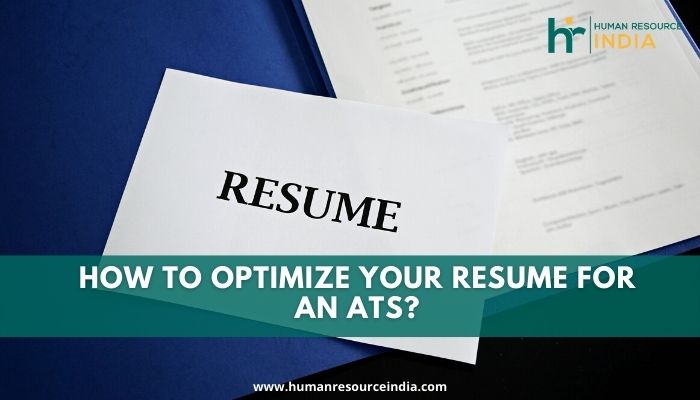How to Optimize Your Resume for an ATS?
- December 14, 2022
- Posted by: Team HRI
- Category: Resume Writing Tips

What is a Resume and Why is It Important?
A resume is a document that describes your education and work experience and is used by employers when they are looking to fill a position. Optimizing your resume to the job you are applying for is essential. An Objective, Work Experience, and Contact Details section can target specific functions or industries. In contrast, skills and education can be used to demonstrate your value to an employer. Some optional sections can be included, such as a Teaching Experience section or a section for research projects that can be used to demonstrate your relevant skills.
It’s an opportunity to sell yourself to an employer in two to three pages. Your resume should be optimized to the job you’re applying for. It should include keywords specific to the position you’re applying for and be easy for a computer to parse. It is your introduction to an employer. It’s your chance to tell a story about yourself in a way that gets past a job listing’s specifications. It’s your opportunity to demonstrate that you’re a better candidate for the position than the person who applied through a recruiter.
Resume screening saves recruiters time during the recruiting process and speeds up new employee onboarding. Whether you screen resumes manually or with software, employing the best techniques can assist you in identifying the most qualified candidates. The issue now is, “What precisely is resume screening?”
How do Recruiters Evaluate and Select Resumes?
When writing your resume, you must remember that a recruiter is evaluating it. A recruiter is looking for the same skills and experiences that you are looking for in a job. A recruiter is also trying to decide whether to continue reading your resume. When you are writing your resume, you want to focus on highlighting your skills and experience.
A traditional approach is to consider each resume in a set of resumes that recruiters have reviewed. A recruiter may have a set of resumes for a job, and they will review each of those resumes on a first-come, first-serve basis. Each resume is read with an eye toward the skills that are relevant to the job.
When a potential employer is looking to fill a position, they are most likely looking to fill it quickly. This means they will be looking for the highest-quality candidates as quickly as possible. When looking to fill a position, a recruiter will evaluate your resume against the job description, your experience, and your education.
Recruiters use a variety of criteria to select candidates, and your resume needs to meet their needs. Some recruiters will ask recruiters to collect and review resumes, which can lead to various approaches. Some recruiters will ask recruiters to find candidates, while others will rely more heavily on LinkedIn profiles.
A recruiter will consider your education and work experience when evaluating your resume. They will also consider your contact information, skills, and accomplishments when evaluating your resume. Some recruiters will also consider your LinkedIn profile and teaching experience when evaluating your resume.
When writing your resume, you want to ensure that you are targeting the right keywords. This will increase the chances that the correct person is seeing your resume. It’s also a good idea to include keywords in the contact section of your resume. This will make it easier for a recruiter to find your contact information if they are searching.
Some recruiters collect and analyze resumes in preparation for an interview. Others may ask recruiters to find the candidates. Others may rely more heavily on LinkedIn profiles.
Also Read : ” How to Create a Standout LinkedIn Profile “
What is Resume Screening?
By narrowing the number of suitable applicants, resume screening plays a crucial role in locating the ideal applicant for a post. Recruiters either check candidates’ resumes directly or use automation to do so. Recruiters analyze each resume manually, whereas software-based resume screening uses artificial intelligence techniques to scan resumes for predetermined criteria. Resume screening is a basic way of weeding out unqualified applications and shortlisting candidates for interviews.
What is an Applicant Tracking System (ATS)?
This application is helpful for human resource managers and talent-acquiring teams aiding in the hiring process. The application tracking system is an off-the-shelf system designed to help all human resources. ATS software lets you view applicants for multiple job openings through a centralized dashboard.
Managers can use an ATS with machine learning (ML) capabilities instead of complicated Excel spreadsheets and pivot tables to aggregate, store, filter, query, and share applications using a centralized dashboard.
Most of the ATS system incorporates messaging and calendar components, which greatly help when you have to automate your e-mail notifications, schedule the interviews, or confirm the interview timings.
Benefits of the ATS System
Increase candidate engagement
This system aids in moving their first contact to the start date, which can be a high-end process. The ATS System creates a web with enhanced visibility across the applicant’s lifecycle.
Cost-effective with increased efficiency
The ATS System creates an opportunity to automate the whole manual procedure, which not only enhances the visibility into the recruitment cycle but aids in enhancing the opportunities for communication throughout a candidate’s journey.
A good catch of worthy candidates
The ATS System addresses the critical challenges that any candidate can face or can go through. It helps in comprehending the candidate’s behavior, amplifying their brand recognition, and also they target the specific kind of job hunter through the platform they use the most.
What is the significance of resume screening by ATS?
With the massive growth in online job boards and the accompanying increases in job adverts, firms generally receive a large number of resumes for a limited number of openings. Resume screening enables recruiters to assess people’s backgrounds and judge their appropriateness for the job and corporate culture.
Resume screening also assists the recruiter in determining whether the job ad’s criteria are reasonable for the employment market. If no applicants have the necessary abilities and years of experience, the recruiter may reconsider their job requirements.
Resume shortcuts
Recruiters do what anyone would do: they seek shortcuts.
Shortcuts, sometimes known as heuristics, allow recruiters to rapidly assess which candidates are likely to be good. On the surface, you can employ a variety of these:
Visual Appearance
Does the resume appear professional? Because this is likely to be the first thing a recruiter performs, optimizing for it is not just a solid approach but also a wise one.
Keeping with the standards
Is it a CV, or does it appear so strange that the applicant most likely does not make sense? This is why many ‘abnormal’ resumes are rejected.
Name
It’s not cool, yet people are prejudiced, bigoted, and so forth. People with difficult-to-pronounce or ethnically charged names (depending on your nation, gender, etc.) are more likely to have better or worse first-scan findings. The good news is that liberal businesses are promoting equality, so anyone with a name that sounds “diverse” may benefit from this.
Recognizable Brands
Any sign of reliability is what you seek. Did you work for reputable firms or attend reputable schools? Anything that individuals may identify with is a benefit. Anything they don’t have is negative. Recruiters, once again, are humans – and they are lethargic.
Recognizable Figures / Influence
This is why they say state numbers. GPAs, test scores, and so on are simple methods to measure and establish credibility.
What are some key points to remember while writing a resume?
Here are a few key points to keep in mind while optimizing your resume:
– Always include keywords and optimize your resume
– Include a contact section with your email and social media platform.
– Include your teaching experience and research projects.
– Avoid mistakes and unprofessionalism.
Also Read : ” How To Recruit Talented Employees For Startups “
Conclusion
Resumes are used to apply for a job. They are used when you are looking for a new job, when you want to update your career, or when you want to apply for a career or volunteer position. In this lesson, you will learn the purpose of a resume, the elements of a resume, and how to write a resume. We will also examine what to include in your resume and what to avoid.
Remember the above points and Optimize your resume accordingly to come out with flying colors.
Human Resource India excels in providing affordable resume writing services. Our industry experts bring with them an outstanding experience of decades which helps the candidates land their dream job. We also help students and job aspirants in clearing their interviews. The entire recruitment process is taken care of. Our services are dedicated to help the potential aspirants achieve a package and an environment which nurtures their development.
Recent Blogs
-
Best Strategies to Improve Hospitality Recruitment Process
Learn the best strategies to improve the recruitment process in the hospitality industry with the help of the best hospitality recruitment agencies.
June 3, 2023 -
What are the Best Ways to Look for Jobs in India?
Looking for a job in India can be a daunting task, especially with the current economic environment.
May 18, 2023 -
What Is Human Resources? The Ultimate Guide Updated 2023
Human Resources is a person, department and employee who works to grow businesses or organisations.
May 7, 2023




